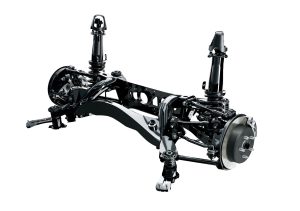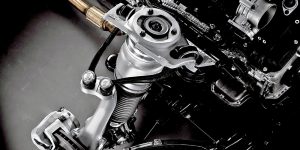The world of automotive engineering has always been a delicate balance between comfort, performance, and safety. Among the many suspension designs developed to meet these goals, the multi-link suspension stands out as one of the most sophisticated solutions. Found in everything from premium sedans to sports cars and even SUVs, this design offers remarkable control over wheel movement, adaptability to different driving conditions, and superior ride quality.
But like any technology, it comes with trade-offs. To understand why many modern cars use multi-link systems, we need to break down what it is, how it works, and its advantages and challenges.
What is a Multi-Link Suspension?

A multi-link suspension is a type of independent suspension that uses three or more separate control arms (links) to precisely guide the wheel’s motion. Unlike simpler setups such as the MacPherson strut or double wishbone, the multi-link design allows each wheel to move with a high degree of freedom while maintaining alignment angles for better handling and tire grip.
Key features:
-
At least three links per wheel (often 4–5)
-
Each link controls a different axis of wheel motion
-
Provides precise camber, caster, and toe control
-
Typically used in rear suspension, but sometimes in the front of high-performance cars
Advantages of Multi-Link Suspension
The popularity of multi-link suspension in modern vehicles is not accidental. It combines the best characteristics of different designs while offering unique benefits.
Main Advantages:
-
Superior ride comfort – absorbs bumps while minimizing vibrations.
-
Excellent handling – wheels maintain optimal road contact during cornering.
-
Reduced tire wear – better alignment angles lead to even tire pressure distribution.
-
Adaptability – can be tuned for comfort in luxury cars or sharp response in sports cars.
-
Noise and vibration control – multiple arms allow for better isolation of road noise.
Table: Multi-Link Suspension vs. Other Designs
| Feature | Multi-Link Suspension | Double Wishbone | MacPherson Strut |
|---|---|---|---|
| Ride Comfort | High | Medium-High | Medium |
| Handling Precision | Very High | High | Medium |
| Cost of Production | High | Medium | Low |
| Space Requirement | Large | Medium | Compact |
| Maintenance Complexity | High | Medium | Low |
Challenges of Multi-Link Suspension
Despite its many advantages, multi-link suspension also presents some significant engineering and practical challenges.
Main Disadvantages:
-
Complexity: With many separate arms, bushings, and joints, the system is difficult to design and manufacture.
-
Higher cost: More components and precision machining raise both production and repair costs.
-
Space requirements: Takes up more room, limiting use in compact vehicles.
-
Maintenance difficulty: Diagnosing wear or replacing parts can be time-consuming.
Table: Common Issues in Multi-Link Suspensions
| Problem | Cause | Effect on Driving |
|---|---|---|
| Worn bushings/joints | High loads, poor roads | Clunking noises, instability |
| Misalignment | Incorrect setup, accidents | Uneven tire wear, poor handling |
| High repair costs | Multiple arms per wheel | Expensive part replacement |
| Space limitations | Complex geometry | Less trunk or cabin space |
Why Automakers Use Multi-Link Suspensions
Even with its complexity, automakers continue to use multi-link suspension in many modern cars because it provides a perfect balance between comfort and performance. Luxury brands like Mercedes-Benz, BMW, and Audi rely heavily on this design, while manufacturers of performance cars appreciate its precision.
Example Applications:
-
Luxury sedans → prioritize comfort with softer tuning.
-
Sports cars → prioritize cornering grip with stiffer setups.
-
SUVs → need adaptability for both road and light off-road driving.
Multi-Link Suspension in Everyday Driving
For drivers, the benefits of multi-link suspension are most noticeable in:
-
Smooth highway cruising → less vibration and fatigue.
-
Sharp turns → car feels stable and planted.
-
Uneven city roads → fewer jolts inside the cabin.
-
Tire longevity → reduced uneven wear compared to simpler systems.
However, owners should be prepared for potentially higher maintenance costs. Replacing worn bushings, control arms, or ball joints can be more expensive compared to simpler strut-based setups.
Tips for Maintaining Multi-Link Suspensions

-
Inspect bushings regularly – worn rubber affects comfort and handling.
-
Check wheel alignment – misalignment causes rapid tire wear.
-
Listen for clunks or knocks – often a sign of worn joints.
-
Don’t overload the vehicle – extra weight stresses components.
-
Use quality replacement parts – cheap components may fail quickly.
If your vehicle requires new components, you can Buy Suspension online to ensure reliability and long-lasting performance.
Conclusion
The multi-link suspension represents the pinnacle of balance in automotive suspension design. While it is more expensive and complex than simpler alternatives, its ability to deliver both luxury comfort and sporty precision makes it highly desirable in modern vehicles. Drivers benefit from better control, smoother rides, and longer-lasting tires — though they should also be prepared for more careful maintenance.
For those who value driving experience, investing in a well-maintained multi-link system is worth it. And when the time comes for repairs or upgrades, choosing the right components ensures your suspension performs exactly as intended.